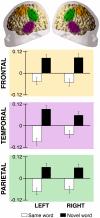Memory in the neonate brain
- PMID: 22087327
- PMCID: PMC3210178
- DOI: 10.1371/journal.pone.0027497
Memory in the neonate brain
Abstract
Background: The capacity to memorize speech sounds is crucial for language acquisition. Newborn human infants can discriminate phonetic contrasts and extract rhythm, prosodic information, and simple regularities from speech. Yet, there is scarce evidence that infants can recognize common words from the surrounding language before four months of age.
Methodology/principal findings: We studied one hundred and twelve 1-5 day-old infants, using functional near-infrared spectroscopy (fNIRS). We found that newborns tested with a novel bisyllabic word show greater hemodynamic brain response than newborns tested with a familiar bisyllabic word. We showed that newborns recognize the familiar word after two minutes of silence or after hearing music, but not after hearing a different word.
Conclusions/significance: The data show that retroactive interference is an important cause of forgetting in the early stages of language acquisition. Moreover, because neonates forget words in the presence of some--but not all--sounds, the results indicate that the interference phenomenon that causes forgetting is selective.
Conflict of interest statement
Figures




References
-
- Mehler J, Jusczyk PW, Lambertz G, Halsted G, Bertoncini J, et al. A precursor of language acquisition in young infants. Cognition. 1988;29:143–178. - PubMed
-
- Nazzi T, Bertoncini J, Mehler J. Language discrimination by newborns. Towards an understanding of the role of rhythm. J Exp Psychol: Hum Percep Perform. 1998;24:756–766. - PubMed
-
- Ramus F, Hauser, MD, Miller C, Morris D, Mehler J. Language discrimination by human newborns and by cotton-top tamarin monkeys. Science. 2000;288:349–351. - PubMed
-
- Eimas P, Siqueland E, Jusczyk PW, Vigorito J. Speech perception in infants. Science. 1971;171:303–306. - PubMed
-
- Werker JF, Tees RC. Cross-language speech perception: Evidence for perceptual reorganization during the first year of life. Infant Behav Dev. 1984;7:49–63.
Publication types
MeSH terms
LinkOut - more resources
Full Text Sources
Other Literature Sources
Medical

